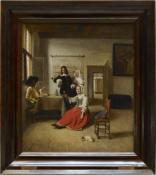- Accès directs
The Woman drinking with soldiers by Pieter de Hooch
Musée du Louvre, Department of Paintings
Pieter de Hooch
(Rotterdam, 1629 - Amsterdam, 1684)
The Woman drinking with soldier
1658
Oil on canvas
Paris, Musée du Louvre, Department of Paintings, inv. RF 1974-29.
Former collection Alphonse de Rothschild ; collection Edmond James de Rothschild ; donated by Mrs Piatigorsky (Jacqueline Rebecca Louise Rothschild), 1974.
After an initial training in Rotterdam, painter Pieter de Hooch pursued his apprenticeship in Harleem with Nicolas Berchem (1620-1683). De Hooch then settled in Delft circa 1650. It is during the Delft period, in 1658, that De Hooch painted the Woman drinking with soldiers. While part of Alphonse de Rothschild’s collection in the Hôtel rue Saint-Florentin, the painting was known as “Good company” (L’Art, 1905). The Delft period can be identified in De Hooch career through more intimate paintings, depicting household themes with a brighter color palette than what he previously used.
In this painting, a woman dressed with a red dress and silver jacket occupies the center of the canvas. A man standing behind her is pouring her wine and an older woman is acting as a matchmaker. The scene takes place indoors. The main space opens into a vestibule from which another room is visible; providing depth to the background. On the right hand side, a painting depicting Jesus and the woman taken in adultery suggests a moralizing reading to this, at first, frivolous scene. De Hooch was particularly fond of this painting within a painting process.
Despite the diversity in themes and genres, the paintings production in Delft in the years 1650 -1675 are characterized by the interest for lighting, perspective and optic. Historiography tends to associate these features with the Delft school. Artists working in Delft during those years influenced each other and proved to be very innovative. Among them, Pieter de Hooch appears as a leading figure. His work was also featured in the collection of Edmond James de Rothschild – the last son of Jacob James de Rothschild (1792-1868) - who owned other masterpieces (The Laundrywoman and The Garden; Prevost Marcilhacy, 2016).
This painting belonged to Alphonse de Rothschild, then to his son. Édouard’s daughter, Jacqueline Rebecca Louise Rothschild (Paris, 1911 - Los Angeles, 2012) later donated the painting to the Musée du Louvre in 1974; along with other masterpieces that were once in the collection of Alphonse de Rothschild including two 16th century ewers bearing the monogram of Gilles de Montmorency-Laval (inv. OA10589 and OA10588)
Laura de Fuccia, Project manager, Institut national d’histoire de l’art, 2019
Further reading
Bibliography
– Bascou, Marc, « Les héritiers du baron Édouard de Rothschild », in P. Prevost-Marcilhacy (dir.), Les Rothschild, une dynastie de mécènes en France, 3 vol., Paris, éditions du musée du Louvre/Bibliothèque nationale de France/éditions d'art Somogy, 2016, III, p. 319.
– Jestaz, Jestaz, « Poteries de Saint-Porchaire », La Revue du Louvre et des musées de France, « Nouvelles
acquisitions », 1975-5-6, p. 384-396 (inv. OA 10588, OA 10589, OA 10590).
– [Paul Leroi], « Le baron Rothschild », L’Art, 3rd S. 1905, n°5, p. 257-293.
– Sutton, Peter, Pieter de Hooch: Complete Edition, Oxford, 1980.
– Sutton, Peter, Pieter de Hooch, 1629-1684 (Exhibition catalog, London, Dulwich Picture Gallery, September 3rd – November 15th 1998, Hartford, Wadsworth Atheneum, December 17th 1998 - February 27th 1999), edited by Peter Sutton, New Haven - London, Yale University Press, 1998, pp. 112-113, n°1 2.
Online Resources
See the themed research dedicated to Alphonse de Rothschild’s collection at the Hôtel de Talleyrand.
See the artwork’s record on the musée du Louvre website: https://www.louvre.fr/oeuvre-notices/Helene-fourment-1614-1673-au-carrosse







 2 Rue Vivienne - 75002 Paris
2 Rue Vivienne - 75002 Paris




